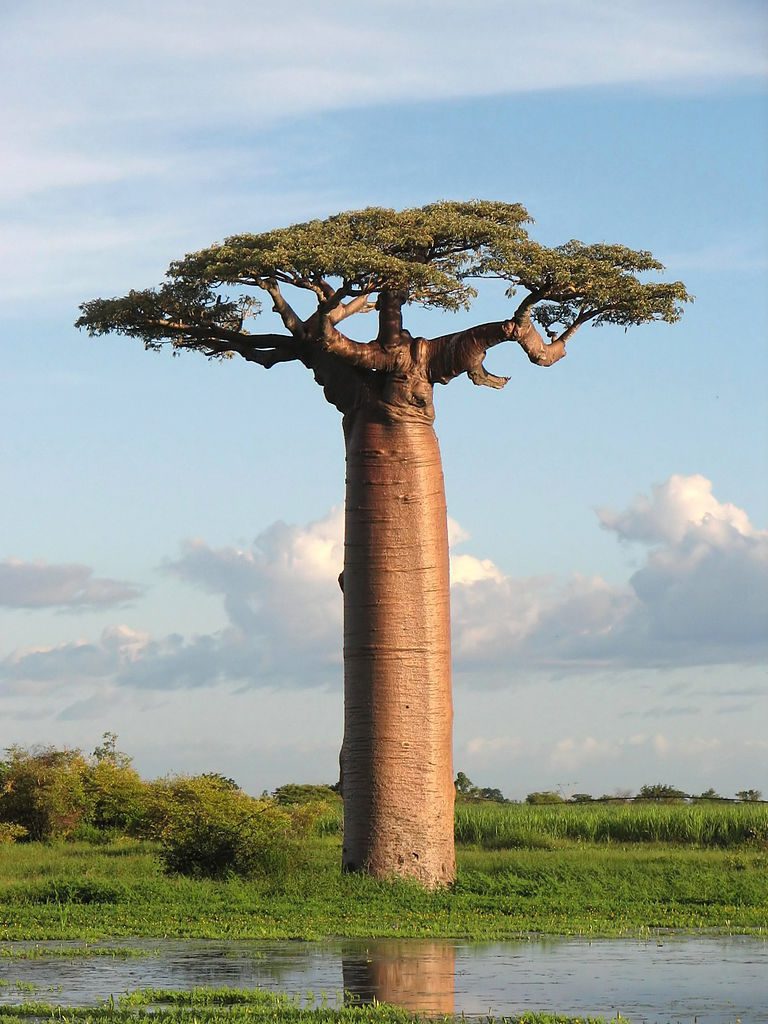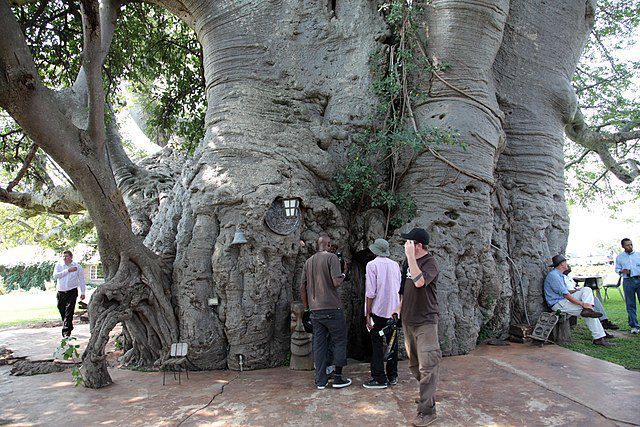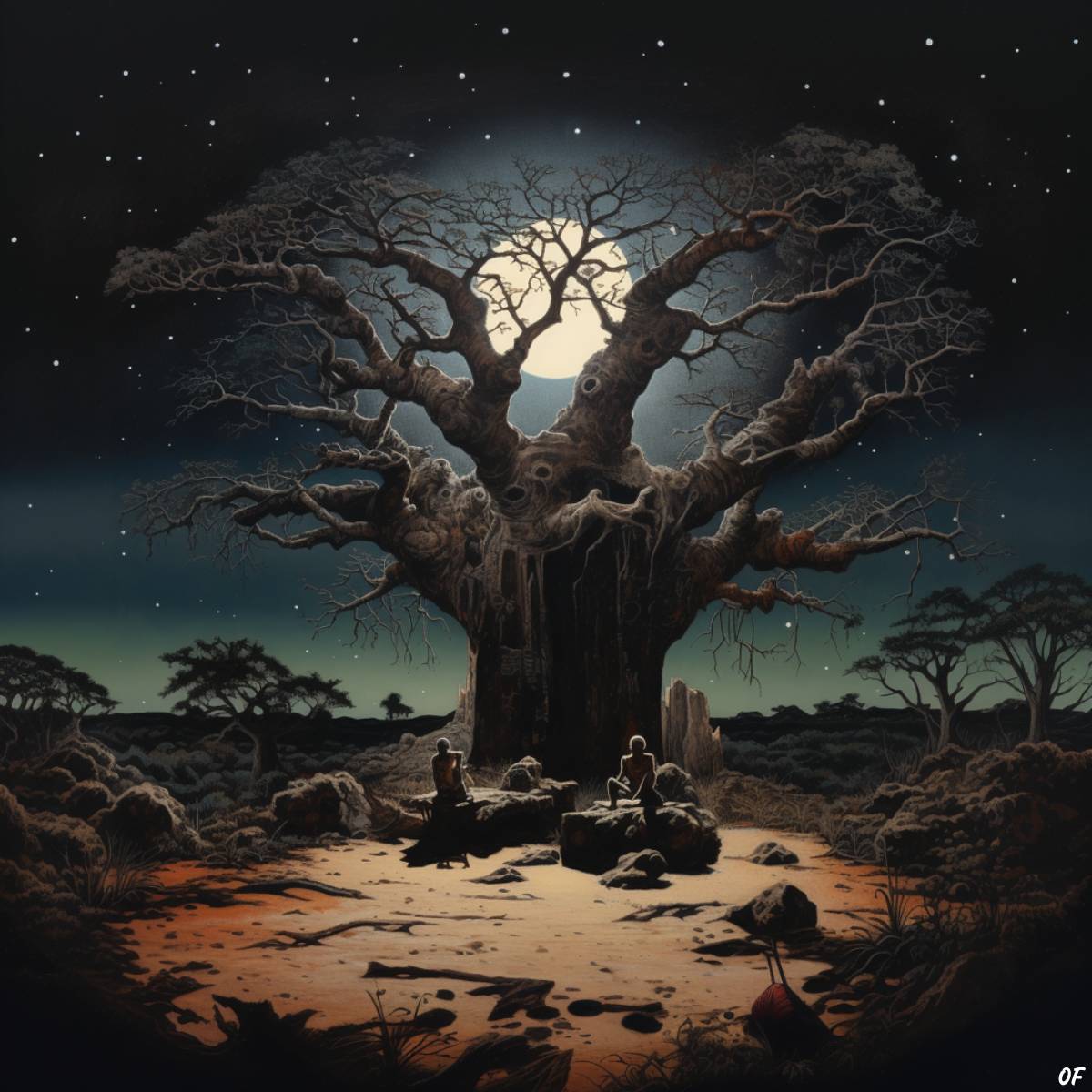Heralded as an emblem of African landscapes, the baobab tree, often referred to as the “upside down tree,” possesses a peculiar charm that has captivated countless generations. Its distinctive appearance, with what looks like a tangle of roots stretching upwards into the sky, gives it an otherworldly quality, as if Mother Nature herself had a whimsical sense of humor.
Permeating the oral tradition of many African cultures are fascinating tales attributing the tree’s unusual orientation to the mythical God, Thora. In one popular legend, Thora, in a fit of rage, flung the baobab out of his heavenly garden. The tree, upon falling to Earth, landed in an upside-down position. However, showcasing fortitude and tenacity, the baobab continued to flourish, growing in spite of its overturned posture as a symbolic gesture of defiance against its divine aggressor.
Yet, a contrasting narrative, ostensibly propagated by Christian missionaries during their evangelistic pursuits, proposes a different origin for the baobab’s inverted demeanor. The story unfolds in the style of Tolkien’s renowned Ents from The Hobbit, where God initially planted the baobabs as motionless entities. As the plot thickens, the baobabs, imbued with a wandering spirit, begin to saunter across the landscape, akin to Tolkien’s walking trees. This incessant movement vexed God, who, in an act of divine intervention, uprooted the trees, inverted them, and replanted them back into the ground. Thus, their ceaseless journey came to an end, leaving them in the unique upside-down position we recognize today.
Both stories, though divergent in their details, present a shared image of the baobab’s silhouette against the African sky—branches splayed out like subterranean roots in the open air, a testament to the timeless allure of this tree and its inextricable connection to the rich tapestry of African lore and landscape.
Gentle giants: the ecological marvels of baobab trees
Bearing witness to centuries of natural history, the iconic “upside down tree,” the baobab, punctuates the landscapes of Central and Southern Africa and nearby islands like Madagascar with its imposing presence. These silent sentinels of the African terrain can reach monumental ages and sizes, testaments to their enduring resilience and unique life cycle.
One such behemoth baobab, tucked away in the heart of South Africa, boasts an extraordinary diameter of 52.5 feet (16 m), rendering it the largest of its kind. The awe-inspiring giant, estimated to be as old as 6,000 years, possesses a circumference equivalent to approximately 154 feet (about 47 m). To further visualize its grandeur, imagine a congregation of 40 adults standing side-by-side, arms outstretched, their collective reach barely encircling this majestic tree.

The baobab tree is akin to an adolescent experiencing rapid growth spurts. These periods of accelerated growth often result in hollow cavities in the trunk, which may house various wildlife, adding yet another layer to the baobab’s ecological significance. Their immense size can be attributed to their remarkable ability to retain water, with the most substantial trees storing as much as 32,000 gallons (120,000 liters) within their trunks. This becomes a valuable resource during the arid seasons when animals, including elephants who harbor a particular fondness for the baobab, gnaw on its bark to quench their thirst. Remarkably, this bark can regenerate over time, underscoring the baobab’s unyielding tenacity.
Diversity within the baobab family is represented by six unique species, each bringing its own charm to the tree’s narrative. Towering above all its kin is Adansonia grandidieri, or the Grandfather’s Baobab, renowned for its colossal stature. Baobabs are known to persist for millennia, with a typical lifespan stretching to at least 3,000 years. Their lifecycle is marked by nocturnal blossoming and the annual shedding of their leaves in the fall, lending an ever-changing aesthetic appeal to these stalwarts of the African wilderness.
This emblem of the African savannah offers much more than meets the eye. This intriguingly structured tree, with its hollowed-out heart, serves as a natural fortress, providing shelter and sanctuary to myriad creatures. Its versatility extends far beyond just a place of refuge; it has been used as a home by indigenous people, a testament to its innate resilience and strength.
Furthermore, the baobab’s bark is a multi-tool in the world of nature. This rugged, fibrous exterior can be manipulated into fishnets and cords, offering a sustainable resource for local communities. In more creative instances, it has even been woven into clothing. Remarkably, the bark, when grounded, also serves as a unique food flavoring, adding a distinctly African touch to various dishes.
The baobab does not limit its generosity to its bark; it extends its bounty to its leaves and seeds as well. The tree’s edible leaves serve as a nutritious addition to meals. Meanwhile, the pulp from the baobab seed was the original source for Cream of Tartar, yielding a tangy beverage reminiscent of lemonade.
From pub to post office: the unexpected uses of baobabs
In a fascinating twist, baobabs have been repurposed as unconventional post offices, jails, and even bars. The most famous among them is arguably the giant baobab located on Sunland Farm in Limpopo, South Africa, which hosted a European-style pub within its massive trunk. Aptly named the ‘Big Baobab Bar,’ it reportedly had to be decommissioned in 2017 after the tree split due to old age. Contrarily, some reports suggest that the pub remains in operation, offering a memorable experience complete with a dartboard, a fully stocked bar with draft beer, fine wines, spirits, and barstools for patrons. According to one anecdote, an astounding group of 54 jovial patrons—presumably petite and quite affable—once crowded into this unique pub for a celebratory gathering.

Sundowners and hidey-holes: baobabs in South African lore
Interwoven into the tapestry of South African history, the baobab tree takes center stage in narratives from the South African War (1899–1902), more commonly known as the Boer War. This conflict, which saw Britain grappling with two Boer republics, featured these formidable trees not merely as silent spectators, but as active participants in the narrative. They were often referred to as “hidey-hole,” providing strategic cover and camouflage amidst the heat of battle, once again, demonstrating their resilience and resourcefulness.
However, the baobab’s role extends beyond historical narratives and into the realm of daily life and culture. The most cherished use for a baobab tree, among many, lies in its pivotal role in the ritual of the “sundowner.” This quintessential South African tradition involves relishing a carefully crafted cocktail, basking in the gentle glow of the setting sun. It’s a moment of tranquility and reflection, a sweet pause in the rush of daily life.
Under the broad, outstretched branches of the baobab, the world seems to slow down, allowing one to fully immerse in the magic of dusk. This is also the time when the light plays on the rugged contours of the baobab, painting a picture that begs to be captured in a photograph. The baobab stands tall, its silhouette etched against the fiery canvas of the sky, serving as the perfect backdrop for these cherished moments of serene contemplation. This majestic tree, through its enduring presence and multifaceted use, continues to etch itself deeper into the cultural and historical ethos of the African landscape.


